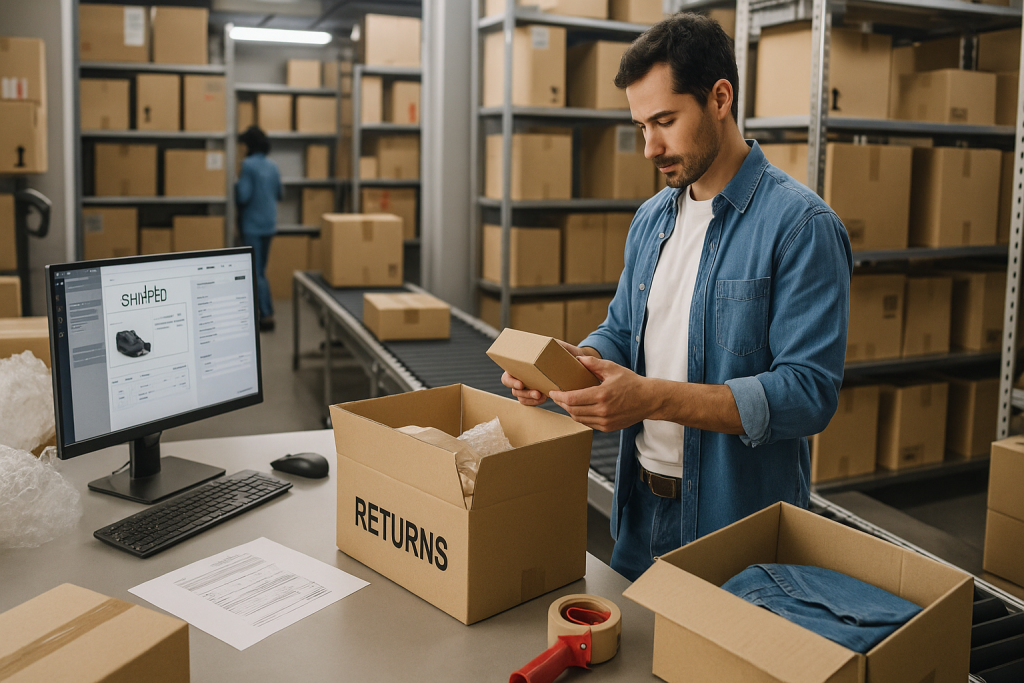By Martin Vassilev / 10 Oct, 2025
The landscape of e-commerce has evolved dramatically. Fast shipping, seamless returns, and sustainable practices are now basic expectations—not value-added perks. At the center of this transformation is reverse logistics, a critical but often overlooked part of the fulfillment ecosystem. As return rates continue to rise and customer loyalty hinges on post-purchase experiences, reverse logistics has moved from a back-end function to a strategic necessity for any serious e-commerce operation.
Reverse logistics involves the entire process of moving goods from the end consumer back to the seller or manufacturer, for returns, repairs, recycling, or proper disposal. Unlike forward logistics, which focuses on getting products to customers efficiently, reverse logistics must deal with unpredictable flows, complex return reasons, and cost management.
In North America, the average e-commerce return rate sits between 15% and 30%, depending on the product category. Fashion, electronics, and home goods see even higher rates. Companies that treat returns as an afterthought risk losing customers permanently. Those that integrate reverse logistics into their core fulfillment strategies gain competitive advantages in retention, sustainability, and operational efficiency.
Returns are expensive. From return shipping to inspection, restocking, and sometimes liquidation, reverse logistics can eat up 20–30% of a company’s margin if not managed strategically. According to the U.S. Environmental Protection Agency, returned products generate millions of tons of landfill waste each year, amplifying environmental pressure.
E-commerce brands that rely on outdated manual processes often face:
Slow turnaround times, leading to unhappy customers.
Inventory inaccuracies, causing stockouts or overstocking.
Hidden operational costs that accumulate across warehousing and transport.
For example, companies that fail to align returns processing with warehouse automation often experience unnecessary delays and excessive labor costs. A better approach is integrating reverse flows with the same efficiency standards as forward logistics. Modern solutions such as automated inspection stations, AI-powered routing, and real-time inventory updates can turn returns from a cost center into a profit-preserving loop.
To improve warehouse efficiency for both outbound and inbound operations, businesses are adopting strategies outlined in guides like How to Maximize Warehouse Efficiency and Cut Costs.
Shoppers expect simple, hassle-free returns. A clear returns policy, free return shipping, and quick refunds are top loyalty drivers. Brands like Amazon and major fashion retailers have set industry benchmarks—making returns frictionless has become a baseline expectation.
Reverse logistics systems that provide real-time tracking, transparent return labels, and automated refund triggers build trust and increase repeat purchase rates. Modern fulfillment centers integrate reverse logistics workflows directly into their fulfillment processes, ensuring consistency from purchase to return.
Governments and environmental organizations are increasingly scrutinizing waste generated by returns. Many companies are now required to comply with waste reduction and recycling regulations. For example, Canada’s Extended Producer Responsibility (EPR) programs and various U.S. state policies mandate proper product disposal and recycling, particularly in electronics and packaging.
By implementing green reverse logistics, such as refurbishing, recycling, or repackaging returned goods, companies not only comply with these regulations but also reduce environmental impact and boost brand reputation. Resources like Canada.ca on waste management provide regulatory frameworks that businesses must increasingly adhere to.
Well-executed reverse logistics enables businesses to recover value from returned products through:
Refurbishment and resale of returned items.
Repackaging and restocking for fast-moving SKUs.
Secondary market sales for slightly damaged or open-box goods.
Efficient reverse logistics systems use data analytics to determine which items should be resold, recycled, or liquidated. As explained in How to Leverage Data Analytics for Streamlined Inventory Management, integrating data-driven decision-making improves both financial recovery and inventory accuracy.
Reverse logistics cannot function in isolation. It must be fully integrated with the broader e-commerce fulfillment network. This includes warehouse operations, transportation, real-time data systems, and customer service.
Automating return authorization through customer portals and backend systems significantly reduces processing time. Customers receive instant instructions, printable labels, or drop-off options, while warehouses receive advance notifications of incoming returns.
AI can analyze return data to route items to the optimal location—whether that’s a central return hub, a refurbishment center, or a resale marketplace. This approach mirrors strategies seen in modern logistics hubs, such as those connecting Calgary and Dallas for efficient cross-border flows.
Returns should flow into the warehouse with the same efficiency as outbound shipments. Automated sortation systems, scanning, and quality checks ensure returned products are processed quickly, allowing real-time inventory updates and immediate resale when applicable.

Automation tools like conveyor sorters, scanning tunnels, and robotic arms accelerate returns handling. Many fulfillment centers are upgrading their infrastructure, as covered in The Future of Warehouse Automation: What Businesses Need to Know, to integrate returns seamlessly into existing workflows.
Reverse logistics requires accurate, real-time inventory visibility to reallocate returned products efficiently. This includes knowing where each item is in the return journey and updating stock levels dynamically.
Data-driven reverse logistics helps companies forecast return volumes, detect fraudulent returns, and optimize processing. AI can flag anomalies, identify frequently returned products, and help businesses adjust product descriptions or quality controls accordingly.
Blockchain offers an immutable record of each return, improving traceability and trust. When integrated with fulfillment operations, it can validate product authenticity, track condition changes, and ensure compliance with regulatory standards.
Many e-commerce companies are using reverse logistics as a cornerstone for sustainability strategies:
Repackaging returned products for resale rather than discarding.
Upcycling and refurbishing damaged items.
Partnering with recycling organizations for products that cannot be resold.
These initiatives not only reduce environmental impact but also attract eco-conscious consumers. Integrating reverse logistics with green warehousing practices strengthens brand image and prepares businesses for tightening sustainability regulations.
The return process starts with clear communication. A transparent, flexible, and easy-to-understand returns policy reduces customer service inquiries and improves conversion rates. Display policies prominently on product pages and confirmation emails.
Establish dedicated return hubs or centralized processing centers to manage returns efficiently. This prevents bottlenecks in main fulfillment warehouses and enables specialized handling.
Reverse logistics data provides valuable feedback on product quality, customer behavior, and supplier performance. Companies can use this intelligence to refine product offerings and reduce future return rates.
Returns handling often involves more steps than outbound fulfillment. Well-trained staff supported by automated systems can process returns quickly and accurately, reducing errors and operational costs.
E-commerce companies that neglect reverse logistics face rising operational costs, regulatory risks, and customer churn. Inefficient return systems lead to:
Overstocking and inaccurate inventory.
Higher labor and transportation expenses.
Negative brand sentiment due to frustrating return experiences.
As competition intensifies, reverse logistics is becoming a defining factor in brand success—not just a logistical afterthought.
Reverse logistics is no longer a niche operation. It is a core pillar of modern e-commerce fulfillment, driving cost recovery, regulatory compliance, sustainability, and customer loyalty. Companies that invest in automated systems, data integration, and sustainable practices will not only lower costs but also gain a powerful competitive edge.
To discuss how to build an end-to-end reverse logistics strategy tailored to your business, contact ByExpress and speak with logistics experts who understand the evolving demands of e-commerce.

“Thanks to Byexpress all my shipping and fulfillment costs are in line now”

“All my issues were solved by Byexpress team that I had with pervious 3pl provider.”

“Thank you Byexpress team could not done it without you guys.”

“Their integration and customer service were the key for me”

“Outstanding delivery service! The package was well-packaged, and
the delivery team was professional and courteous”

“Great and knowledgeable team to work with.”

Thanks, guys, for reducing my shipping rates
Ottawa Office
2411 Holly Lane
Ottawa, ON, K1V 7P2
Toronto Office
13-280 West Beaver Creek Road Unit #136
Richmond Hill, ON, L4B 3Z1
Alexandria Office
173 Kenyon Street West
Alexandria, ON, K0C 1A0
Montreal Office
4388 Saint-Denis Street Unit #200
Montreal, QC, H2J 2L1
California Office
155 North Riverview Drive
Anaheim Hills, CA, 92808
Call Us
Toll-Free: 1-866-744-7122
Local : 613-739-3000
Email Us
Multilingual Services










